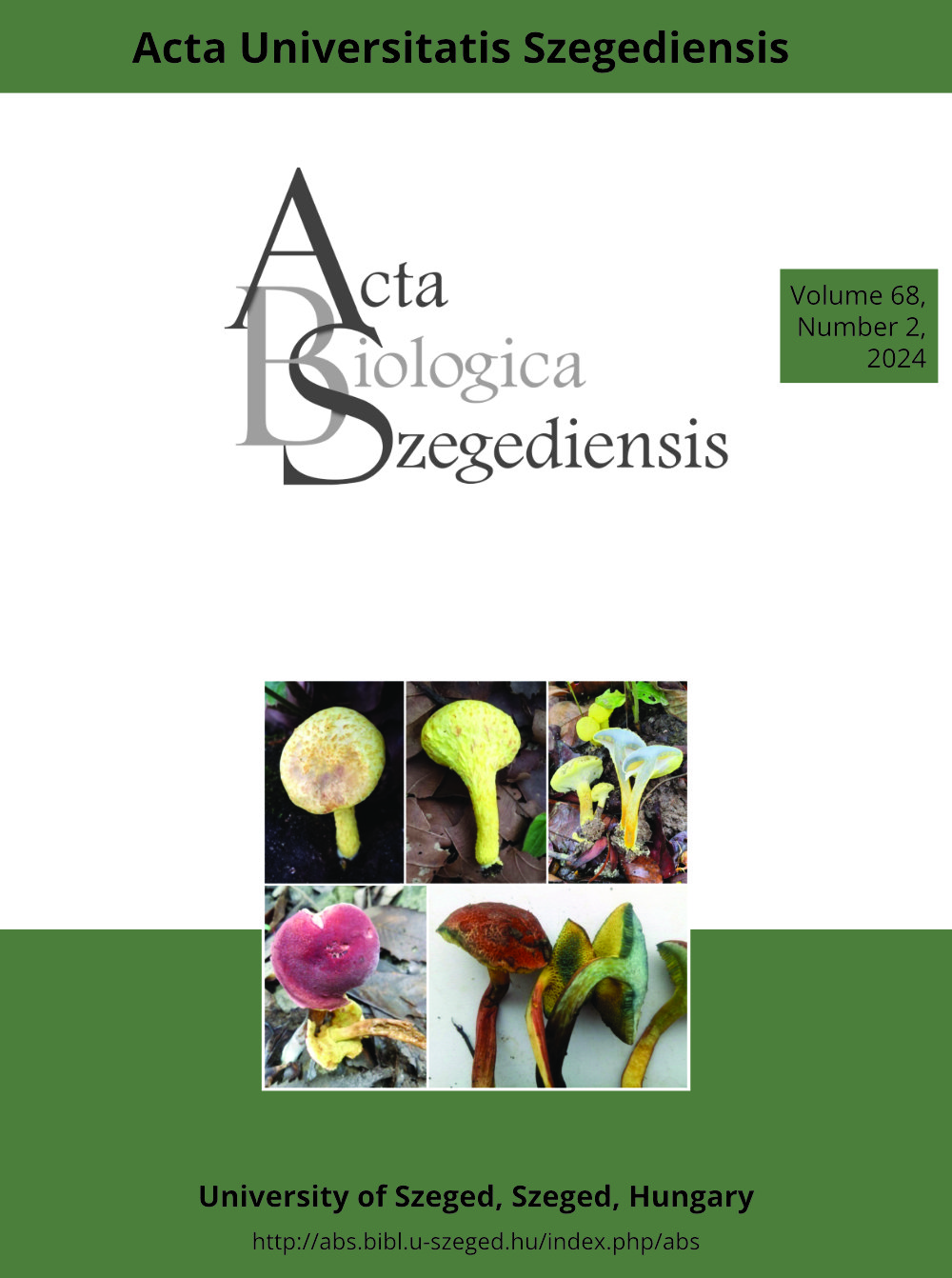Lesser Kestrel (Falco naumanni) ground prey abundance during its breeding season in central Greece
DOI:
https://doi.org/10.14232/abs.2024.2.142-150Keywords:
Ground prey, Lesser Kestrel, Pitfall traps, Prey abundance, ThessalyAbstract
The Lesser Kestrel (Falco naumanni) is a bird of prey, highly dependent on agricultural landscapes for foraging. This study examines the availability of its prey in different crop types within the Thessalian Plain, central Greece, and assesses how agricultural practices in different cultivations influence prey abundance. Results indicate variations in prey abundance among different crops and study periods. Fallow/ uncultivated fields and legume crops provided the highest prey availability, particularly for key prey groups such as Coleoptera and Orthoptera, making them crucial for Lesser Kestrel foraging. In contrast, intensive crops such as maize and cotton exhibited lower prey abundance, particularly in early growth stages, thus limiting their suitability as foraging habitats. The findings highlight the impact of intensive and extensive agricultural practices on Lesser Kestrel prey populations. Sustainable land management strategies are essential for supporting Lesser Kestrel conservation in agroecosystems.
Downloads
References
Ausden M, Drake M (2006) Invertebrates. In Sutherland WJ, Ed. Ecological Census Techniques: A Handbook. Cambridge University Press, New York, pp. 214-249.
Bensusan KJ, Cortés JE (2007) Decline of the Lesser Kestrel (Falco naumanni) in Gibraltar: Possible causes, conservation and action plan. Almoraima 35:185-190.
Calabuig G, Ortego J, Cordero PJ, Aparicio J (2010) Colony foundation in the Lesser Kestrel: patterns and consequences of the occupation of empty habitat patches. Anim Behav 80:975-982.
Carmona DM, Landis DA (1999) Influence of refuge habitats and cover crops on seasonal activity-density of ground beetles (Coleoptera: Carabidae) in field crops. Environ Entomol 28:114 5-1153 .
Catry I, Amano T, Franco A, Sutherland WJ (2012) Influence of spatial and temporal dynamics of agricultural practices on the Lesser Kestrel. J Appl Ecol 49:99–108.
Catry I, Dias MP, Catry T, Afanasyev V, Fox J, Franco AMA, Sutherland WJ (2011) Individual variation in migratory movements and winter behaviour of Iberian Lesser Kestrels Falco naumanni revealed by geolocators. Ibis 153:154-164.
Chatenet GD (1986) Guide des coleopteres d’Europe. Tome 1. Delachaux et Niestlé, Paris.
Chinery M (1993) Insects of Britain and Western Europe. Collins Field Guide. HarperCollins, New York.
Christakis C, Sfougaris A (2021) Foraging habitat selection by the Lesser Kestrel Falco naumanni during the different phases of breeding and the post breeding period in central Greece. Ornithol Sci 20(2):175-183.
Christakis C, Makri M, Alivizatos H, Sfougaris A (2023) Lesser Kestrel Falco naumanni diet during different phases of breeding and post breeding periods in central Greece. Avocetta 47:2023F002.
De Frutos A, Olea P, Mateo-Tomas P, Purroy FJ (2010) The role of fallow in habitat use by the Lesser Kestrel during the post-fledging period: inferring potential conservation implications from the abolition of obligatory set-aside. Eur J Wildl Res 56:503-511.
Donázar J, Negro J, Hiraldo F (1993) Foraging habitat selection, land-use changes and population decline in the Lesser Kestrel Falco naumanni. J Appl Ecol 30:515-522.
Franco A, Catry I, Sutherland W, Palmeirim J (2004) Do different habitat preference survey methods produce the same conservation recommendations for Lesser Kestrels? Anim Conserv 7:291-300.
Franco A, Marques JT, Sutherland WJ (2005) Is nest-site availability limiting Lesser Kestrel populations? A multiple scale approach. Ibis 147:657-666.
Garcia JT, Morales MB, Martinez J, Iglesias L, De-la-Morena EG, Suarez F, et al. (2006) Foraging activity and use of space by Lesser Kestrel Falco naumanni in relation to agrarian management in central Spain. Bird Conserv Int 16:83-95.
Greenslade P, Greenslade PJM (1971) The use of baits and preservatives in pitfall traps. J Aust Entomol Soc 10:253-260.
Greenslade PJM (1964) Pitfall trapping as a method for studying populations of Carabidae (Coleoptera). J Anim Ecol 33(2):301-310.
Gustin M, Ferrarini A, Giglio G, Pellegrino SC, Frassanito A (2014) Detected foraging strategies and consequent conservation policies of the Lesser Kestrel Falco naumanni in Southern Italy. Proc Int Acad Ecol Environ Sci 4(4):148-161.
Holland JM (2004) The environmental consequences of adopting conservation tillage in Europe: reviewing the evidence. Agric Ecosyst Environ 103:1-25.
Iñigo A, Barov B (2010) Action plan for the Lesser Kestrel Falco naumanni in the European Union. SEO|BirdLife and BirdLife International for the European Commission.
Kopij G (2002) Food of the Lesser Kestrel (Falco naumanni) in its winter quarters in South Africa. J Raptor Res 36 (2):14 8 -152 .
Legakis A, Maragou P (2009) The Red Book of Endangered Animals of Greece. Hellenic Zoological Society, Athens, Greece.
Limiñana R, Romero M, Mellone U, Urios V (2012) Mapping the migratory routes and wintering areas of Lesser Kestrels Falco naumanni: new insights from satellite telemetry. Ibis 154:389-399.
McGavin GC (2000) Insects, Spiders and Other Terrestrial Arthropods. Dorling Kindersley Handbooks. Dorling Kindersley, London, UK.
McLaughlin A, Mineau P (1995) The impact of agricultural practices on biodiversity. Agric Ecosyst Environ 55:201-212.
Natural Environment and Climate Change Agency (NECCA) (2024) The Greek Red List of Threatened Species. Athens, Greece. Available: https://redlist.necca.gov.gr.
Nagy A, Solymos P, Racz I (2007) A test on the effectiveness and selectivity of three sampling methods frequently used in orthopterological field studies. Entomol Fenn 18:149-159.
Negro J (1997) Falco naumanni lesser kestrel. J Birds West Palearct 1(1):49-56.
Negro JJ, Bustamante J, Melguizo C, Ruiz JL, Grande JM (2000) Nocturnal activity of lesser kestrels under artificial lighting conditions in Seville, Spain. J Raptor Res 34(4):327-329.
Olfert O, Hinks CF, Biederbeck VO, Slinkard AE, Weiss RM (1995) Annual legume green manures and their acceptability to grasshoppers (Orthoptera: Acrididae). Crop Prot 14:349-353.
Parisi V, Menta C, Gardi C, Jacomini C, Mozzanica E (2005) Microarthropod communities as a tool to assess soil quality and biodiversity: a new approach in Italy. Agric Ecosyst Environ 105:323-333.
Perez-Granados C (2010) Diet of adult lesser kestrels Falco naumanni during the breeding season in central Spain. Ardeola 57(2):443-448.
Pfiffner L, Luka H (2003) Effects of low-input farming systems on carabids and epigeal spiders – a paired farm approach. Basic Appl Ecol 4(2):117-127.
Pietersen DW, Symes CT (2010) Assessing the diet of Amur falcon Falco amurensis and lesser kestrel Falco naumanniusing stomach content analysis. Ostrich 81:39-44.
Rodríguez C, Wiegand K (2009) Evaluating the trade-off between machinery efficiency and loss of biodiversity-friendly habitats in arable landscapes: the role of field size. Agric Ecosyst Environ 129:361-366.
Rodriguez C, Johst K, Bustamante J (2006) How do crop types influence breeding success in lesser kestrels through prey quality and availability? A modeling ap-proach. J Appl Ecol 43:587-597.
Rodriguez C, Tapia L, Kieny F, Bustamante J (2010) Temporal changes in lesser kestrel (Falco naumanni) diet during the breeding season in southern Spain. J Raptor Res 44(2):120-128.
Rodriguez C, Tapia L, Ribeiro K, Bustamante J (2014) Crop vegetation structure is more important than crop type in determining where lesser kestrels forage. Bird Conserv Int 24(4):438-452.
Schmidt MH, Clough Y, Schulz W, Westphalen A, Tscharntke T (2006) Capture efficiency and preservation attributes of different fluids in pitfall traps. J Arachnol 34:159-162.
Sfougaris A, Giannakopoulos A, Alivizatos C, Weigelt C (2004) Conservation of a raptor in an intensively cultivated agroecosystem: the case of lesser kestrel (Falco naumanni) in Thessaly plain, central Greece. In Arianoutsou M, Papanastasis VP (Eds) Proceedings of the 10th MEDECOS Conference. Millpress, Rotterdam, pp 1-10.
Skvarla MJ, Larson JL, Dowling APG (2014) Pitfalls and preservatives: a review. J Entomol Soc Ont 145:15-43.
Stoate C, Borralho R, Araújo M (2000) Factors affecting corn bunting Miliaria calandra abundance in a Portuguese agricultural landscape. Agric Ecosyst Environ 77:219-226.
Tella J, Hiraldo F, Donazar-Sancho J, Negro J (1996) Costs and benefits of urban nesting in the lesser kestrel. In: Bird D, Varland D, Negro JJ (Eds) Raptors in Human Landscapes: Adaptation to Build and Cultivated Environments. Academic Press, Cambridge, pp 53-60.
Tella JL, Forero MG, Hiraldo F, Donazar JA (1998) Conflicts between lesser kestrel conservation and European agricultural policies as identified by habitat use analyses. Conserv Biol 12(3):593-604.
Tella J, Forero M (2000) Farmland habitat selection of wintering lesser kestrels in a Spanish pseudosteppe: implications for conservation strategies. Biodivers Conserv 9:433-4 41.
Topping CJ, Sunderland KD (1992) Limitations to the use of pitfall traps in ecological studies exemplified by a study of spiders in a field of winter wheat. J Appl Ecol 29(2):485-491.
Ursua E, Serrano D, Tella JL (2005) Does land irrigation actually reduce foraging habitat for breeding lesser kestrels? The role of crop types. Biol Conserv 122:643-648.
Weeks RD, McIntyre NE (1997) A comparison of live versus kill pitfall trapping techniques using various killing agents. Entomol Exp Appl 82:267-273.
Weibull A, Ostman O (2003) Species composition in agro-ecosystems: the effect of landscape, habitat, and farm management. Basic Appl Ecol 4:349-361.
Willemse F (1984) Fauna Graeciae I. Catalogue of the Orthoptera of Greece. Hellenic Zoological Society, Athens, Greece.
Willemse F (1985) Fauna Graeciae II. A key to the Orthoptera species of Greece. Hellenic Zoological Society, Athens, Greece.
Woodcock BA (2005) Pitfall trapping in ecological studies. In Leather RS (Ed) Insect sampling in forest ecosystems. Blackwell Science, Oxford, pp 37-57.
Downloads
Published
How to Cite
Issue
Section
Funding data
-
European Commission
Grant numbers LIFE11 NAT/GR/001011








